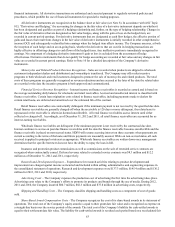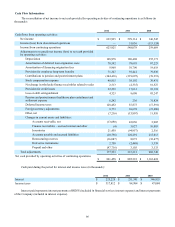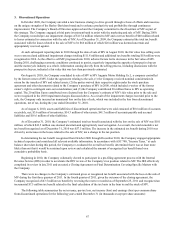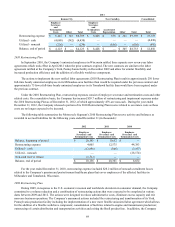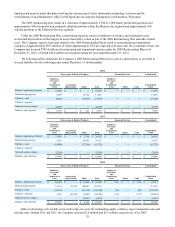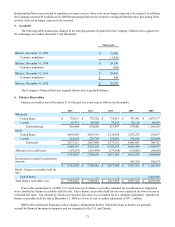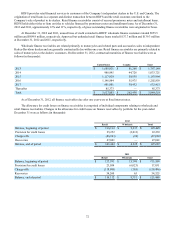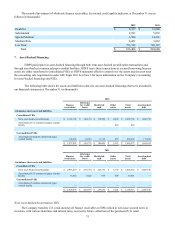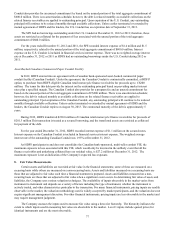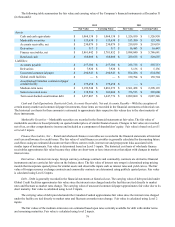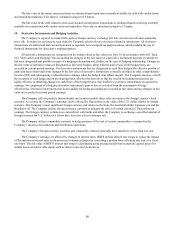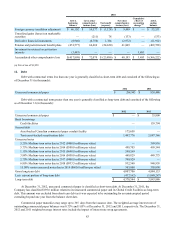Harley Davidson 2012 Annual Report Download - page 73
Download and view the complete annual report
Please find page 73 of the 2012 Harley Davidson annual report below. You can navigate through the pages in the report by either clicking on the pages listed below, or by using the keyword search tool below to find specific information within the annual report.
73
Changes in the allowance for credit losses on finance receivables for the year ended December 31 were as follows (in
thousands):
2010
Balance, beginning of period $ 150,082
Allowance related to newly consolidated finance receivables (1) 49,424
Provision for credit losses 93,118
Charge-offs, net of recoveries (119,035)
Balance, end of period $ 173,589
(1) As a part of the required consolidation of formerly unconsolidated VIEs done in connection with the adoption of the new requirements within ASC
Topics 810 and 860 on January 1, 2010, the Company consolidated a $49.4 million allowance for credit losses related to the newly consolidated
finance receivables.
The allowance for credit losses and finance receivables by portfolio, segregated by those amounts that are individually
evaluated for impairment and those that are collectively evaluated for impairment, at December 31, were as follows (in
thousands):
2012
Retail Wholesale Total
Allowance for credit losses, ending balance:
Individually evaluated for impairment $ — $ — $ —
Collectively evaluated for impairment 101,442 6,225 107,667
Total allowance for credit losses $ 101,442 $ 6,225 $ 107,667
Finance receivables, ending balance:
Individually evaluated for impairment $ — $ — $ —
Collectively evaluated for impairment 5,073,115 816,404 5,889,519
Total finance receivables $ 5,073,115 $ 816,404 $ 5,889,519
2011
Retail Wholesale Total
Allowance for credit losses, ending balance:
Individually evaluated for impairment $ — $ — $ —
Collectively evaluated for impairment 116,112 9,337 125,449
Total allowance for credit losses $ 116,112 $ 9,337 $ 125,449
Finance receivables, ending balance:
Individually evaluated for impairment $ — $ — $ —
Collectively evaluated for impairment 5,087,490 824,640 5,912,130
Total finance receivables $ 5,087,490 $ 824,640 $ 5,912,130
Finance receivables are considered impaired when management determines it is probable that the Company will be
unable to collect all amounts due according to the loan agreement. As retail finance receivables are collectively and not
individually reviewed for impairment, this portfolio does not have specifically impaired finance receivables. A specific
allowance is established for wholesale finance receivables determined to be individually impaired in accordance with the
applicable accounting standards when management concludes that the borrower will not be able to make full payment of the
contractual amounts due based on the original terms of the loan agreement. The impairment is determined based on the cash
that the Company expects to receive discounted at the loan’s original interest rate and the fair value of the collateral, if the loan
is collateral-dependent. In establishing the allowance, management considers a number of factors including the specific
borrower’s financial performance as well as ability to repay. At December 31, 2012 and 2011, there were no wholesale finance
receivables that were individually deemed to be impaired under ASC Topic 310, “Receivables”.
Retail finance receivables accrue interest until either collected or charged-off. Interest continues to accrue on past due
wholesale finance receivables until the finance receivable becomes uncollectible, at which time the finance receivable is placed
on non-accrual status. The Company will resume accruing interest on these wholesale finance receivables when payments are
current according to the terms of the loan agreements and future payments are reasonably assured. At December 31, 2012 and
2011, there were no wholesale finance receivables on non-accrual status.


